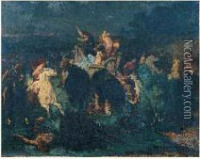Evariste Luminais Paintings
Évariste Vital Luminais was a French painter born on October 13, 1821, in Nantes, France. He is recognized for his historical and genre paintings, particularly those depicting scenes from ancient Gaulish and Frankish history. Luminais received his artistic training at the École des Beaux-Arts in Paris under the tutelage of influential artists such as Léon Cogniet and François-Édouard Picot.
Luminais was a part of the French academic art movement, and he gained a reputation for his skill in dramatic composition and his ability to evoke a sense of grandeur and historical significance in his works. He debuted at the Paris Salon in 1843 and continued to exhibit there throughout his career, receiving several medals for his paintings. His works were well-received, and he was awarded the Legion of Honour in 1864, which is one of the highest recognitions in France for contributions to the arts.
Some of Luminais' most famous paintings include 'The Sons of Clovis II,' which depicts the legend of the Merovingian royal children being thrown into the sea, and 'The Abduction of the Sabine Women.' His paintings often featured robust, heroic figures and were characterized by their vivid detail and emotional intensity.
Throughout his career, Luminais also contributed to decorative projects, most notably the ceiling painting for the Théâtre du Châtelet and the Pantheon in Paris. He was an influential figure in 19th-century art and inspired subsequent generations of painters with his evocative portrayals of historical subjects.
Évariste Vital Luminais died on May 14, 1896, in Paris. His legacy continues to be celebrated in the history of French art, and his works are held in numerous museum collections, including the Musée d'Orsay and the Musée des Beaux-Arts de Nantes. Luminais remains a notable figure in the canon of French academic painting and is remembered for his contributions to the genre of historical painting.

















